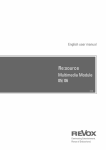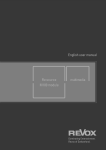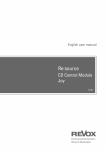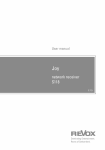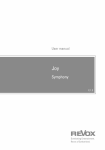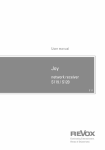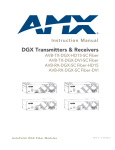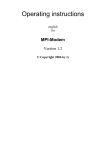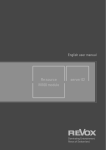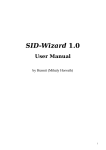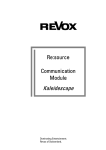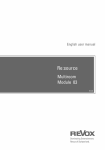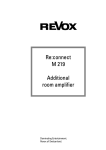Download Revox Re:source MMM User's Manual
Transcript
as82
of
Re:source
Multi Media
Module
MMM
Dominating Entertainment.
Revox of Switzerland.
Re:source
Multi Media
1
Re:source
Multi Media
of
Multi Media Module MMM
Installation
Connection panel
3
4
5
Glossary NETWORK TERMINOLOGY
Cabling
7-10
11
Multi Media Module Setup
Setup #1 IP-/ MAC addresses
Setup #2 Device Name
Setup #3 SSID/ Security Mode
Setup #4 WEP Key
Setup #5 WPA Key
Setup #6
Setup #7
Setup #8
Setup #9
Setup #10
.
12.
13
14
15-16
17
18
19
19-20
20
21
21
DHCP
Manual IP Settings
Manual DNS Settings
Proxy Server
Manual Proxy Settings
MMM Operation
Operating in Multiroom operation
General control softkeys
Info status overview
.
SelectionUSB
SelectioniPod
SelectionInternet Radio
SelectionUPnP-AV Server
SelectionMyMusic
22.
23-24
25
26
27
28
29-30
31
32
M208 Operation – MyMusic
M208 Remote control
MyMusic synchronisation
.
33.
34
35
Internet Audio Portal [IAP]
Setting up Internet Radio
Revox Internet Audio Portal (IAP)
Initial logon
IAP Registration page
Managing Revox IAP
Adding radio stations to FAVOURITES
.
36.
36
37
37
38
39
40
Network: Questions & Answers
41-43
Technical data
Guarantee and scope of delivery
Note COPYRIGHT
44
45
45
2
Re:source
Multi Media
MULTI MEDIA MODULE MMM
The Program Director
As the name suggests, you won't
just have access to a wealth of
storage media. With Internet Radio,
you will also have access to the
whole world. The days are gone
when Program directors decided
what you could listen to and then
subjected
you
to
intrusive
advertising and traffic reports as
well. Now, you are your own
Program director. You can select
your own music genre of choice
and listen to broadcasts at a time
that suits you.
The Memory Stick
When connected to the USB
socket, any memory stick and any
USB hard disc* can make its
contribution to the media diversity
of the MMM.
The Music Folder
The MMM brings order into you
favourite collection of CDs. Just
pack all the tracks that make up
your collection onto a network disc
in the highest quality and then
browse through them at your
leisure, looking for long-lost tracks
or
rediscovering
some
old
favourites. No more looking for
CDs that have been put back into
the wrong box!
The Language Trainer
Or how would it be if, just ahead of
your holiday, you could listen again
to the language of the country you
are going to visit? No problem with
Internet Radio. First select the
continent and then the country and
before you know it, Spanish, Creole
or French will be coming at you out
of the "ether".
The Multiroom Factor
Many of your friends will also be
comfortable in the world of Internet
Radio and will appreciate a network
player. But the MMM isn't just at
your service in the main room but
in every other room that your
Multiroom system is connected to.
And that could be as many as 32!
The iPod Connection
Your MMM will get on very well
with your iPod. Just connect it to
the MMM and using your Revox
equipment, you can dive into the
audiophile world offered by this
clever little box of tricks.
* with FAT16/32 formatting
3
Re:source
Multi Media
INSTALLATION
The Multi Media Module is equipped
with the latest electronics and
should be handled with care.
Loosen the two screws with the
TORX screwdriver supplied and
remove the blanking plate.
Before you install the card, the M51/
M10 must be switched off and
separated from the power supply,
by plugging the unit out.
Before removing the MMM module
from its packaging, you should
make sure that you are not
statically charged. This could cause
a damaging discharge of voltage
when you touch the module. You
should get rid of any static charge
by touching an earthed metal
object like a radiator, for example.
M51 Installation
.
The MMM can be operated in slots
1 - 6. The only exception is Slot 7,
next to the speaker connections, as
this is reserved for the 5.1 Decoder
module.
!
Remove the MMM from its
packaging and feed it into its plugin position. The two bars inside the
M51/ M10 are the mechanical
guides for you to use.
For loading reasons, only one
MMM should be installed in an
M51.
The lettering on the MMM plug-in
card must be on top. Shortly before
the plug-in card is fully locked into
position in its slot, you will feel a
mechanical resistance, caused by
the bus board contact strip. Push
the MMM fully in by applying
pressure in the area of the two
screw holes and fix the card in
place with both screws.
M10 Installation
.
The MMM can be operated in slots
1 - 8 or A 1 - 2. Slots A1 and A2
should only be fitted with second
generation modules, like the MMM,
that have the following symbol on
them: G²
!
Up to 4 MMMs can be installed in
parallel in an M10.
All further steps for registering the
new module are carried out
automatically the next time you
switch on.
4
Re:source
Multi Media
CONNECTION PANEL
WLAN
Connection for the WLAN aerial
included with the accessories. The
aerial must be installed to set up data
communication to the MMM using a
wireless LAN.
The WLAN connection is deactivated if a
LAN connection is established.
►
►
LAN
RJ45 connector for a LAN router in
the network.
The WLAN connection is deactivated as
soon as a LAN connection is established.
USB1
USB A connection for an external USB
mass storage (ext. USB hard disc with its
own power supply, USB memory stick) that
is formatted with a FAT16 or FAT32 file
system.
►
1
The USB storage may not
exceed the maximum power
consumption as defined by
USB specifications. You
should only use USB hard
discs with their own power
supply or memory sticks.
²
Charging the iPod battery
Your iPod's battery is
charged up while it is
being used. No charging
occurs however, while the
M10/ M51 is in standby
mode. Permanent charging
is possible using the optional
Revox Docking station that
will be available in 2009.
Portable Player²
Sub-D 15connector for an iPod. There are 3
options for establishing the connection to
the iPod:
1) Direct to the iPod using the adapter
cable (supplied)
►
2) Using the Revox iPod Docking station
(not supplied)
3) Using the MMM Enhancer for large
distances between the MMM and the
iPod or the iPod Docking station.
(not included)
5
Re:source
Multi Media
Important advice
The following description for the
cabling and the setup makes the
assumption that there is a
functioning network with router
available and operational.
If you have any questions about
the setup and configuration of
your network or Internet access,
please refer to your System
administrator or an IT specialist
of your choosing.
WLAN Wireless communication
An access point is required for the
wireless communication between
the MMM and the router. This can
be an external unit or it can be
integrated in the WLAN router.
Internet Radio
If you want to use the MMM to
receive Internet radio, there must
be a broadband Internet access to
the router. Setting up the Internet
access may involve further costs.
The management and use of the
Revox Internet Radio Portal is freeof-charge and already included in
the purchase price.
6
Re:source
Multi Media
Glossary
NETWORK TERMINOLOGY
General
the outside world actually to be
established, the MMM must additionally
be informed of the address of the router
(Gateway).
The network switch ensures the correct
connections between the individual
components. In order to make this
possible, each device within a network
must be capable of being uniquely
identified. Each component therefore, is
given its own address, the so-called IP
address. The IP address is made up
four blocks of numbers, each of which
can contain up to three digits. These
blocks of numbers are separated by a
full stop, e.g. 192.168.1.1.
It must be ensured that the first three
blocks of the Device IP, the Gateway IP
and the DNS 1 are within the same
address range, e.g. 192.168.0.xxx. The
fourth block assigns a unique address
("house number") to the components in
the local network. This number may
only occur once within the local
network. The Device IP mask should
always be given the address
255.255.255.0.
Each of the individual blocks of digits
can have a value between 1 and 254.
The values 0 and 255 are in part
reserved for special functions and
therefore shouldn't be used. In order to
ensure a secure function of your
network, addresses from the predefined range should be used, i.e.:
fundamentally, the first two blocks
should be 192.168.xxx.xxx; the third
block can be selected from the values
in the range mentioned above (must be
the same for all the devices within a
network however) and the fourth block
should be used to differentiate each
device,
e.g.:
MMM 192.168.001.001
NAS: 192.168.001.002
PC:
192.168.001.003
DNS
The Domain Name System (DNS) is
one of the most important services in
the Internet. Its main task is that of
converting Internet address like
www.revox.de for example, into its
corresponding IP address. As a rule,
the router in home networks fulfils the
function of the DNS.
If you should decide for the manual
network configuration (without DHCP),
just enter the address of your router as
the DNS address during network
configuration.
If you don't just want to use devices
within the local network but also music
sources from the Internet (Internet
radio), the MMM must have the
possibility of being able to access the
Internet. This can be achieved, for
example, through a router with a
connection to a DSL network. This
router is also a part of the network and
will be assigned its own IP address. In
order to enable this connection to
LAN
Local Area Network
Local cabled network
A LAN connection to the MMM is the
most fault-tolerant and problem free
transmission technology, which offers
much
more
security
against
eavesdropping than WLANs or Power
LANs.
7
Re:source
Multi Media
Gateway
MAC Address
The computer or router in your network
through which the data traffic with the
world outside your network, i.e. the
Internet is handled.
The MAC address (Media Access
Control) is the unique hardware
address that is used for the
unambiguous identification of the
device in the network.
With the MMM, the MAC address can
either be read out in Setup on Page #1
or alternatively, if it has not yet been
installed, from the MAC sticker on the
back of the module.
Client
Network device that draws data out of
the network, decodes it and converts it
for example, into analogue music
signals, which then can be played
through amplifiers and speakers.
Streaming clients also contain functions
for displaying media content and for
navigating in the Internet or on servers.
NAS
Network Attached Storage. As a rule,
this is a storage device with a very
large capacity > 500 GB, which other
devices can access. If the NAS server
contains an UPnP-AV server service,
the MMM can access and play media
files that are stored on the NAS.
DHCP
DHCP is an abbreviation for Dynamic
Host Configuration Protocol. DHCP is
primarily used to enable clients to fetch
their network configuration automatically
from a server or router.
The MMM supports DHCP.
Power Line – LAN
With the Power Line LAN, data is
transmitted through the existing power
cable network. So-called Power Line
Modems are required on the transmitter
and receiver side. As a rule, Power
Line LANs offer reasonably fault-free
data transmission with a data rate
sufficient for audio streaming. We
recommend Power Line Modems with
bit rates of 85 or 200 MBit/s.
IP Address
Network address. Each device in the
network needs an IP address through
which it can be reached and uniquely
identified. Network addresses may not
occur twice. This is important if network
addresses are assigned manually. If
addresses are issued in your network
through DHCP, you don't need to worry
about the IP address assignment as
the DHCL server automatically handles
the question of address management.
8
Re:source
Multi Media
Glossary
NETWORK TERMINOLOGY
SSID
Proxy Server
A proxy or proxy server is a computer
in the network that makes data transfer
quicker and more efficient and that can
also increase security by deploying
access control mechanisms. Usually,
you do not find proxy servers in home
networks. In such a case, you don't need
to define a proxy address during the
MMM network configuration.
The MMM allows the use of a proxy
server.
Service Set Identifier / Network name.
SSID designates the identification of a
radio network that is based on IEEE
802.11.
Each
WLAN
has
a
configurable, so-called SSID or ESSID
(Extended Service Set IDentifier), to
identify the radio network.
It represents the name of the network.
The SSID character string can be up to
32 characters long. It is configured in
the base station (WLAN router / Access
point) of a wireless LAN and defined on
all the clients that should have access
to it.
Router (WLAN Router)
A central network device that
establishes
and
manages
the
communication between the network
devices.
Current devices increasing combine the
function of the router with the function
of an access point for wireless data
communication. These combi-devices
are often referred to as WLAN routers.
Normally, the (WLAN) router in a
network takes on the function of the
gateway to the outside world.
UPnP-AV
Universal Plug and Play – Audio Video
Network standard that makes media
content, e.g. on PCs or NAS discs
accessible in networks.
A UPnP-AV software must be installed
on PCs /NAS storage so that the MMM
can access the stored media data.
Below, you will find a short overview of
UPnP software that is suitable for the
different operating systems:
Server
A network device that makes data and
services available for other devices in
the network. A UPnP-AV server stores
for example, audio and video media
data and makes this data available to
other devices, the streaming clients.
Often, UPnP-AV servers also offer
functions for the cataloguing and easy
identification
of
medial
content
according to criteria such as artist,
album name, genre, etc.
Windows:
Twonky Media Server
http://www.twonkyvision.de/
Windows Media Player 11
http://www.microsoft.com/windows/win
dowsmedia/de/default.aspx
Linux:
Mediatomb
http://mediatomb.cc/
GmediaServer
http://www.gnu.org/software/gmediaser
ver/
9
Re:source
Multi Media
WLAN (W-LAN, Wireless LAN)
Radio network. Network connection is
done using radio waves in the 2.4 GHz
frequency range. Radio networks are
easy to install as no cables have to be
laid but are often problematic and
unreliable, particularly over longer
transmission distances. In many cases,
Power Line networks that also don't
require any cabling are a better choice.
WEP
Wired Equivalent Privacy (WEP) is the
previously used standard encryption
algorithm for WLANs. It should control
access to the network as well as
ensuring the confidentiality and integrity
of the data. Because of various weak
spots, the process is considered to be
unsafe. For this reason, WLAN
installations should use the more
secure WPA encryption. See WPA.
With WPE authentication, a distinction
is drawn between two processes:
In each case, the installation of a
network cable is the most fault-tolerant
and
problem
free
transmission
technology. An additional point is that
cabled networks don't produce any
electro smog.
Open
Open System Authentication is
standard authentication. The WEP
is used at the same time
authentication: Each client with
correct WEP key gets access to
network.
WPA
Wi-Fi Protected Access (WPA)
WPA contains the architecture of WEP,
but offers additional protection through
dynamic keys that are based on the
following (Cipher) standards:
- Temporal Key Integrity Protocol (TKIP)
- Advanced Encryption Standard (AES)
the
key
for
the
the
Shared
Shared Key Authentication is reputed to
be the more secure version. In this
case, authentication is done through
the Challenge-Response authentication,
with a secret key. However, the
Challenge-Response process is also
based on WEP and demonstrates the
same weaknesses.
WPA offers Pre- Shared Keys (PSK)
for authentication or Extensible
Authentication Protocol (EAP) through
IEEE 802.1x.
The MMM offers both Open and Shared
WEP authentication.
The MMM is based on the
authentication PSK and supports both
the WPA encryption TKIP and AES.
Wi-Fi
Certificate for WLAN products that work
according to IEEE802.11 standards
and are compatible with other products.
10
Re:source
Multi Media
CABLING
if the communication between router (WLAN) and MMM
should be wireless, the dotted LAN connection may
not be in place.
NAS
: Network hard disc / Network Attached Storage Device
UPnP-AV
: Universal Plug and Play – for Audio- / Video transfer
The MMM can only communicate with NAS or servers
that support the UPnP-AV standard, which was specially
developed for the streaming of audio and video content.
USB
: USB mass storage, either a USB memory stick or
an external hard disc (with its own power supply)
11
Re:source
Multi Media
SETUP Multi Media Module
Important advice
The basic settings for the MMM are
made in Setup.
The following description for the
Setup makes the assumption that
there is a functioning network with
router available and operational.
Select Media from the Source
menu and press and hold the
Setup key for approx 2 seconds.
Then select the Source softkey.
The following display appears:
There is no further explanation of
the specialist terminology used in
the individual chapters. You will find
an extensive description of these in
the previous chapter "Glossary
NETWORK TERMINOLOGY"
If you have any questions about the
setup and configuration of your
network or Internet access, please
refer to your System administrator
or an IT specialist of your choosing.
All settings that are needed to set
the MMM up are done on a total of
eleven Setup pages, whereby only
the relevant pages are shown.
Setup pages that you don't need
because of a setting you have
made are hidden.
Input field in Setup [...]
Whenever you can make a setting
within an input field in the following
chapters, the area that is to be
changed appears in the display in
two square brackets [...].
Example: Setup #6
Use DHCP? YES
M51
Inputs at the M51 are
made using the rotary knob. At
the same time, the small red lamp
(Jog) next to the rotary knob lights
up.
By selecting YES the settings on
#7 and #8 in the IP and DNS area
respectively are automatically
made by the MMM. These Setup
pages therefore, are not shown.
You switch directly from Setup #6
to Setup #9.
M10
Inputs at the M10 are
made through the display panels
from the M230 or M233 service
programs. In the case, you use the
fields Jog ±.
12
Re:source
Multi Media
Setup #1
IP Address
MAC Address
The first page shows the IP
address that the MMM used to
login to the network.
Display of the MAC address that
has been uniquely assigned to this
MMM.
L This is important for logging in to the
Revox Internet Audio Portal (IAP)
The MAC address must be defined
WITHOUT the colons shown here, in
order to log the MMM in to the
Revox Internet Audio Portal, which
offers the configuration of the
Internet radio.
If the MMM could not login
because of an incorrect Setup
setting or because of a network
problem, the following display
appears in the IP Address area:
Example above:
MAC Address: 00:1b:9e:87:cb:58
Revox IAP:
001B9E87CB58
In this case, you should check the
network and/ or the settings you
made.
Device Name
The Device name, which the MMM
identifies itself in the network is
displayed in the lower area of the
display field. The Device Name can
be selected as required for each
MMM. Setup #2 shows you how
can generate a new name.
L Restart
The MMM must be restarted using
the Restart softkey if Setup
changes have been made, in order
for the changes to be applied. This
softkey is only available on Setup
#1.
13
Re:source
Multi Media
Setup #2
Device Name [...]
Each device on the network can
have its own Device Name, as well
as its individual MAC address.
The selected Device Name
appears in the headline of the
display and also in a list of network
clients.
Some network clients generate
these device names automatically,
which doesn't always result in a
clear identification of the device in
question.
M51 Display view
Each MMM on the other hand, can
be assigned its own, descriptive
device name. This can be up to 11
characters long and is displayed in
the headline of the MMM Main
menu.
M217 Display view
The [...] cursor is moved left and
right with the
and
softkeys. The
softkey
inserts a character to the left of the
[...] cursor. The
softkey
deletes the character where the [...]
cursor is currently positioned.
14
Re:source
Multi Media
Setup #3
SSID [...]
MMM aerial is not lined up correctly.
Change the position and carry out
a new search with the
softkey.
Here, you define the name of your
network's SSID.
If the required network is not found
even though all conditions are
fulfilled and the following display
appears, it is possible that the
cabled access (LAN) is already in
place or the network name, (SSID),
is hidden by the Access Point. In
this case, the SSID must be
entered manually, see SSID.
The [...] cursor is moved left and
and
right with the
softkeys. The
softkey
inserts a character to the left of the
[...] cursor. The
softkey
deletes the character where the [...]
cursor is currently positioned.
SSID search
Alternatively, you can execute a
search with the
softkey,
followed by a listing of all the
networks found.
Select network
If the required network is visible,
you select it with the
softkeys and confirm your
choice with the
softkey. You
quit Setup #1 with the
softkey. The existing setting in
Setup #3 is retained.
Example of an SSID list:
The list is displayed in Setup #11.
If, unexpectedly, the required
network is not visible, it is possible
that the Access Point (WLAN
Router) is badly positioned or the
15
Re:source
Multi Media
Setup #3
Security Mode
Setup #4 and #5 with restart
The encryption method can be
selected or modified to that of the
WLAN router with the Security
softkey.
Further Setup pages (#4 for WPE
settings and #5 for WPA-PSK
settings) are now accessible,
depending on the selected
encryption method.
Carry out a restart of the MMM with
the Restart softkey, after
configuring Setup pages #4 and/or
#5. Otherwise, the existing
encryption method is retained.
There are three options. You can
make your choice from an endless
softkey.
loop using the
None
WEP
WPA-PSK
None There is no encryption!
WEP
WPA-PSK
16
Re:source
Multi Media
Setup #4 [
WPE]
WEP Key [...]
Authentication (WEP)
WEP encryption is done using a
WEP key that is defined once for
the router and all WLAN devices.
The MMM offers both the WEP
authentications Open and Shared.
Enter your WLAN network WEP
key here.
The required authentication can be
set through the
softkey.
The [...] cursor is moved left and
and
right with the
softkeys respectively.
The
softkey inserts a
character to the left of the [...]
cursor. The
softkey
deletes the character where the [...]
cursor is currently positioned.
NOTE
A change in this menu requires a
restart to be carried out.
Your WEP key is only shown
encrypted after a restart.
NOTE
A change in this menu requires a
restart to be carried out.
17
Re:source
Multi Media
Setup #5 [
WPA PSK]
WPA Key [...]
WPA Cipher
WPA encryption is done using a
WPA key that is defined once for
the router and all WLAN devices.
The MMM offers both AES and
TKIP as WPA cipher (encryption
standard).
Enter your WLAN network WPA
key here.
The required encryption standard
can be set through the
softkey.
The [...] cursor is moved left and
and
right with the
softkeys respectively.
The
softkey inserts a
character to the left of the [...]
cursor. The
softkey
deletes the character where the [...]
cursor is currently positioned.
NOTE
A change in this menu requires a
restart to be carried out.
Your WPA key is only shown
encrypted after a restart.
NOTE
A change in this menu requires a
restart to be carried out.
18
Re:source
Multi Media
Setup #6
Setup #7
DHCP
IP-Address [...]
Using the
softkey, you can
define whether logging in to the
network should be done
automatically DHCP Yes, or
whether the required setting will be
made manually DHCP No.
The 4 blocks of the IP address that
the MMM should have, are set
using the two Address softkeys.
In a network of DHCP-enabled
LAN devices, you must always
ensure that these are NOT given the
MMM's IP.
Setup pages #7 and #8, where the
corresponding settings (IP,
Gateway, DNS, etc.) can be made,
are accessible if you select the
setting DHCP No. You get to
these Setup pages with the
softkey.
IP Mask [...]
The 4 blocks of the IP subnet mask
that the MMM should have, are set
using the two Mask softkeys.
You get directly to Setup page #9
where the Proxy setting can be
made, if you select the setting
DHCP Yes.
NOTE
A change in this menupoint
requires a restart to be carried out.
NOTE
A change in these two menupoints
requires a restart to be carried out.
19
Re:source
Multi Media
Setup #7
Setup #8
IP Gateway [...]
DNS Server 1 / 2 [...]
Access to the Internet is defined
through the two Gateway softkeys.
The IP addresses of the DNS
serves 1 and 2 can be entered
using the DNS 1 and DNS 2
softkeys respectively.
If such a data exchange should be
done outside the LAN, the IP
Gateway must be configured
according to the on-site
requirements.
NOTE
If the MMM is connected with a
standard (WLAN) router, the IP
address of this router can simply be
entered here.
In this case, the DNS address of
the second server (2) does not
have to be configured.
A change in one of these two
menupoints requires a restart to be
carried out.
NOTE
A change in these two menupoints
requires a restart to be carried out.
20
Re:source
Multi Media
Setup #9
Setup #10
Proxy Server
Proxy Server Address [...]
You can define whether
communication should be done
using a Proxy server with the
softkey.
The 4 blocks of the Proxy Server
address is defined using the two
Proxy softkeys.
The setting Use Proxy ? Yes,
makes Setup page #9 accessible,
where the corresponding settings
(Proxy address, Port) can be
made. You get to this Setup page
softkey.
with the
Proxy Server Port [...]
The corresponding Proxy Server
port can be defined using the two
Port softkeys.
With the setting Use Proxy ?
No, Setup page #9 is skipped.
NOTE
A change in this menu requires a
restart to be carried out.
NOTE
A change in these two menupoints
requires a restart to be carried out.
21
Re:source
Multi Media
MMM Operation
Once all the required settings have
been made in the MMM Setup, the
Multi Media Module (MMM) can be
called in the M51 Source menu
and/or through the keys on the
M217/M218 combination that were
assigned through the Remote
menu.
The following Start screen appears
in the initial seconds after calling
the source Media:
The manual always shows the M51
display view to illustrate working
with the MMM. In terms of content,
this display view is identical to that
of the M217 wall display. The only
difference is the resolution and/or
modified structure for the selection
of menupoints.
During this start phase, the MMM
searches for connected devices
(USB storage, iPod) and/or
network devices (NAS) and the
Internet access for using Internet
radio.
Once the Start phase is completed,
the selection options that have been
found are listed.
The most important menus and
selection options available for
operating the MMM through an
M217/M218 display combination
are shown on the next pages.
The MMM displays the new source
Media in the Source menu.
Source menu with Media
Detailed explanations of these
options follow in the next chapters
and you will be shown how you can
define the search for particular
tracks, albums or radio stations.
22
Re:source
Multi Media
M217/ M218 operation
M217 Menu overview
Thanks to the sophisticated Revox
Multiroom concept, it is possible to
operate the MMM from each
additional room that is connected to
the Multiroom system.
The following menu overview
shows the most important M217
menus for operating the MMM. As
the selection menus are very
dependant on the choice of devices
connected to the MMM (USB, iPod,
clients, etc.) it is possible that the
graphics differ from your M217
menus.
M217
Part
MMM Main menu
USB selection by artist
M218
Call the MMM Main menu though
the source keys on the M218
keyboard (grey keys) that you
assigned in the Remote setup of the
source, Media.
iPod selection
In the same way you use the M218
keyboard to control the volume [Vol ±]
as well as changing track [<>],
assuming that the selection menu
supports this, (chequered keys).
Internet Radio selection
Further operation of the MMM is
done through the softkeys on the
M217 display, (black keys).
23
Re:source
Multi Media
Part
M217 Menu overview
Network client selection
Menu: Now Playing
+MyMusic selection
You can add the radio station currently playing
and/or the path to your favourite music tracks to
the MyMusic category by pressing the +MyMusic
softkey. We recommend however, only adding
music storage paths to MyMusic that are always
available.
ABC search
The alphabetically sorted selection allows a specific
selection based on names that start with a
particular letter. This can be names of folders, titles
or radio stations.
Info window
The Info softkey shows the status of the currently
selected source. In the example shown on the left,
the track The Winner Takes It All by ABBA from
the album Super Trouper is playing.
Menu selection
The Menu softkey opens the navigation or control
page with the selection: Back , ABC..., Home,
(Info), MyMusic.
You will find a functional description for these
selection options on the next page, chapter
General control softkeys.
24
Re:source
Multi Media
General control softkeys
Softkey ABC...
The alphabetically sorted selection
allows a specific selection based
on names that start with a
particular letter. This can be names
of folders, titles or radio stations.
The ABC search can only be used
with sorted lists. The following
message appears with unsorted
lists:
„unsorted list...“
Softkeys +MyMusic
You can add the radio station
currently playing and/or the path
to your favourite music tracks to
the MyMusic category by
pressing the +MyMusic softkey.
We recommend however, only
adding music storage paths to
MyMusic that are always available.
e.g. a path to a permanently
connected USB hard disc.
Softkey Back
This key returns you to the next
highest menu level.
Please do not confuse this with the
Favorites softkey that calls an
existing Internet Radio Favorites
list.
Softkey Browse
The Browse softkey opens a folder
or a category and takes you to the
next selection level.
NOTE
The MMM is purely a reproduction
medium that plays the content of
different media such as USB
storage, iPod, Internet radio, etc.
The MMM cannot modify the
content of these media or delete
parts or add new items.
Softkey Home
Returns you to the Main menu.
Softkeys Page
Page up/down within a list.
Softkeys Select
Line up/down within a list.
Softkeys Previous/ Next
Scroll to next or previous track or
radio station
25
Re:source
Multi Media
Info - Status overview
The Info softkey shows the status
of the currently selected source.
Wifi Level [%]
The Wifi level displays the
strength of the Access point
reception. If this should get
too low, you may have to reposition
it.
The Wifi level does not indicate
anything about the speed of the
Internet access.
In the example shown below, the
track When I Kissed The teacher
by ABBA from the Album Arrival is
playing. This title was stored with a
data rate of 192 Kbps.
The Wifi level is displayed
permanently, even in the case of
sources that do not receive their
data over the WLAN, e.g. a USB
hard disc.
L
Walls, atmospheric pressure and
humidity affect the quality of the
WLAN wireless connection, as well
as the positioning of the components.
Bit rate [kpps]
The data rate with which the
selected radio station transmits or a
track was compressed.
Buffer [%]
The filling level of the MMM data
buffer that is used to balance out
MMM fluctuations in the data
streaming. The buffer display should
always be 100%. If it reaches 0%,
playback is stopped until data is
received again.
26
Re:source
Multi Media
USB
The USB menu enables access to
content on connected USB storage
media (USB Memory stick*, external
USB hard disc* with its own power
supply).
The Play softkey only appears once
a track is available for selection.
Press Play to start the playback of
the title:
All tracks and music folders are
displayed after the USB selection is
made. You can make your selection
using the Page and Select
navigation softkeys. The Browse
softkey opens folders containing
more than one track.
You can scroll to the preceding or
the following track within the folder /
album respectively, using the
Previous and Next softkeys.
L
The track names are defined by the
names of the music files. ID3 tags
are not supported for selection.
*with FAT16/32 formatting
27
Re:source
Multi Media
iPod
The iPod menu allows access to
content on the connected iPod.
Press Play to start the playback of
the title:
The selection options in the iPod
menu are predefined by the iPod
and are not handled by the MMM
controller. For this reason, it is
possible that new or modified
selection options will be added in
the future. At the time of printing
this manual, the following selection
criteria were available:
•
•
•
•
•
•
•
You can scroll to the preceding or
the following track respectively within
the list / album, using the Previous
and Next softkeys.
Playlists
Artists
Albums
Songs
Genres
Composers
Audiobooks
NOTE
iPod name
The headline of the display shows the
name of the iPod that was assigned to it
with iTunes, in this case ReVox iPod.
You can make your selection using
the Page and Select navigation
softkeys. The individual selection
criteria are selected with the Browse
softkey.
Charging the iPod battery
Your iPod's battery is charged up while
it is being used. No charging occurs
however, while the M10/ M51 is in
standby mode. Permanent charging is
possible using the optional Revox
Docking station that will be available in
2009.
28
Re:source
Multi Media
Internet Radio
The selection Internet Radio gives
you access to thousands of radio
stations available from around the
world. As well as the linguistic
diversity available, you can also
make specific selection based on
particular musical directions
(Genres).
Podcasts offer even more
individuality. Podcasts are broadcasts such as news programs,
magazine shows, crime dramas,
comedies, etc. that are started when
you select them. You don't switch
onto a program that is currently
running as is usual when listening to
(internet) radio. You actively start the
playback of a program.
The selection options in the
Internet Radio menu are being
constantly been adapted to meet
customer requirements. For this
reason, it is possible that new or
modified selection options will be
added in the future. At the time of
printing this manual, the following
selection criteria were available:
•
•
•
•
•
•
•
•
Starting Internet Radio
Select the menupoint Internet
Radio in the Main menu.
The current selection options are
displayed:
29
Favorites
Added Stations
Location
Genre
Podcasts By Location
Podcasts By Genre
New Stations
Most Popular Stations
Re:source
Multi Media
Favorites
Your favourite radio stations or
groupings that you have previously
organised through Revox Internet
Audio Portal are listed under
Favorites. How to do this and what
you have to take into account is
described in the chapter Setting up
Internet Radio on page 33.
Genre
Listing of radio stations based on
certain music directions such as
rock, jazz, folk, etc. Within the genre,
the individual radio stations are
either listed alphabetically (All
Stations) or by the countries offering
this type of music.
Podcasts By Locations
Listing of podcast transmissions
based on the country/continent
where the provider is located.
Added Stations
The selection Added stations lists
those radio stations that you added
yourself in the Revox Internet Audio
Portal (see chapter IAP, page 34),
as these are not listed by default.
You need the URL, the Internet path,
of the operator of the radio station to
be able to add a new Internet radio
station in the IAP. You will usually
find this on the provider's homepage
or you can display them in a media
player.
Podcasts By Genres
Listing of podcast transmission
based on the genre, which these
transmissions are assigned to.
New Stations
New radio stations are being added
somewhere in the world every day.
As you won't want to go to the effort
of searching for new radio station
arrivals every day yourself, these are
listed in the selection New Stations.
Location
Selection of radio station by
countries. Searching for the required
radio stations is made quick and
specific through the classification in
Continents Countries Genre.
Most Popular Stations
Listing of the Internet radio stations
that are currently being listened to
the most.
30
Re:source
Multi Media
UPnP-AV Server
Menu from the Revox NAS server in the
development department:
Network servers that support the
UPnP-AV standard can be
accessed through the network
(LAN or WLAN). The most usual
instance of such a server is a NAS
hard disc.
The name of a media server is
defined at the server itself.
You can make your selection using
the Page and Select navigation
softkeys, as with all other media
content. The individual selection
criteria are selected with the Browse
softkey.
It is however possible to use a
normal PC as a network server.
This though requires a UPnP-AV
software so that the MMM can find
a play stored music files. Such a
software is offered, for example, by
the company Twonky Vision with
the software TwonkyMusic.
Important:
Folder name Music
!
The MMM can only find your music
tracks on the media server if they
are located in a folder called
Music. Other folder names are not
recognised.
This folder can be displayed with
another name than Music in the
media server MMM folder. This is
very much dependant on the
settings and the various models of
these media servers. In the
example shown above, the network
folder Music is shown in the display
headline as Musik.
The way a menu from such a
UPnP-AV server looks can be very
different, depending on the
configuration.
Menu from the Revox M37 MK2 Music
server:
31
Re:source
Multi Media
MyMusic
The MyMusic selection on the start
page covers all your favourites that
you have added through the MMM
menu. This can include paths to
music tracks on USB storage media
or network hard discs or also
favourite radio stations. We
recommend however, only adding
music content storage paths to
MyMusic that are always available.
You can make your selection using
the Page and Select navigation
softkeys. You start the playback with
the Play softkey.
L Favorites - Internet radio
You will find the second selection of
favourites with the name Favorites
in the Internet radio area. This
selection can only be organised
through the Revox Internet Audio
Portal at a PC and it contains
Internet radio stations. How you
organise them is described in the
next chapter.
- see Internet Radio setup-
Select MyMusic directly through the
MyMusic softkey or go through the
menu with the Browse softkey.
Deleting a MyMusic entry
Entries / paths can be deleted from
the MyMusic list with the Remove
softkey. The actual music track
remains on the storage medium.
Only the link is deleted.
A list appears with previously
stored favourite music tracks
and/or radio stations. Each entry
that is listed here has been added
with the +MyMusic softkey.
Please note: Delete track
Before deleting the music track from
a storage medium (USB, NAS, etc.),
you should first remove the path to
this track with Remove. Otherwise,
the entries continue to point to tracks
that in fact no longer exist on the
media storage.
32
Re:source
Multi Media
M208 Operation - MyMusic
There is a separate mpi file called
Revox Multimedia Module in the
M208 Project Manager device
library, for controlling the MMM in
the MyMusic area.
The are several navigation options
to help you find the desired entry in
the list in the shortest time:
Jump to
start
As the description in this manual
relates to the system software
V2.00+, it is important to use the
corresponding M208 Project
Manager V2.01 or higher. The
MMM doesn't support older
versions.
Jump
Page▲
Jump
to end
Single jump▲
OK
Jump
Page▼
Single jump▼
You can transfer all entries in the
MyMusic area to the M208 remote
control with the MMM user
interface.
A synchronisation with the M208
should always be carried out if you
modify any of the MyMusic entries
in the MMM by adding new ones or
deleting existing ones. Otherwise,
wrong MyMusic entries will be
called.
After synchronising, select the
required MyMusic entry using the
navigation compass and confirm
this with the OK key. Shortly after
pressing the OK key, playback of
the corresponding track or Internet
radio program will start.
L Synchronisation with the M208
How to carry out a synchronisation
with the M208 remote control is
described in the chapter
Synchronising MyMusic.
L Multiroom operation
This control option can be used
both in the main room and in all
additional rooms.
33
Re:source
Multi Media
M208 Remote control
Basic settings
Switching M51/M219 off
Change sound track
Select subtitles
Change angle
Show details
List selection
Cover selection
Sound setting
Volume control
Chapter/track up/down
Mute
Call menu
Confirm/Execute
Navigation
(in the menu)
Cancel
Pause / Freeze frame
Playback
Stop
Jump forwards/back
Search forwards/back
Number pad for
direct access
Show details
Pause change
34
Re:source
Multi Media
Synchronising MyMusic
Synchronisation now starts and
only takes a few seconds. When
the synchronisation is complete,
the following display appears:
The following display appears the
first time the MMM is started on the
remote control:
The MyMusic selection has not yet
been synchronised in this
constellation.
Now, all stored MyMusic entries
appear in the display the next time
the MMM controller is called. The
display order is determined by the
order they were stored in the
MMM.
Connect the M208 with the supplied
USB cable to the M208 Link interface for synchronisation. The Link
interface for its part is connected to
the M10 / M51 through a cable to
the M Link.
Once the connection is established,
select the source key at the M208
where the MMM controller is stored
and press the SETUP key. Confirm
the setting Synchronize with the
OK key.
L
A synchronisation with the M208
should always be carried out if you
modify any of the MyMusic entries
in the MMM by adding new ones or
deleting existing ones. Otherwise,
wrong MyMusic entries will be
called.
Important advice
The M208 remote control must not
be operated while synchronisation
is running.
35
Re:source
Multi Media
Setting up Internet Radio
The list of radio stations that
appears in the Internet Radio
category in your Multimedia
Module is made available by a
service provider and transferred to
your MMM through the Internet
connection. You can extend and
edit the Favorites and Added
Stations lists in the Internet Radio
menu in the Online Services
category as you wish, through
Revox's Internet Portal.
This is done as follows: Open your
Internet Browser and call the
Revox Homepage under:
www.revox.de
Germany
www.revox.ch
Switzerland
www.revox.com
English
Under the option "Online Services",
call the Revox Internet Audio
Portal, where you can register and
configure your MMM.
To the Internet Audio Portal
36
Re:source
Multi Media
Internet Audio Portal - IAP
How to do this is described in the
next chapter: Initial login
You can login (Member Login) if
your MMM has already been
registered in the Internet Audio
Portal (IAP). If this is not the case,
you can register with
Revox Internet Audio Portal start page
Initial login
Press Source softkey.
You must register your MMM in
order to be able to use the IAP
service. Registration is done using
your MMM's MAC address, your email address and password that
you define for yourself.
When logging in for the first time,
please enter the MAC address of
your MMM. This uniquely identifies
your MMM. You will find the MAC
address in the MMM Setup menu
on Page #1.
e MAC address is made up of six
pairs of characters, e.g.:
00:1b:9e:87:cb:58. Don't enter
the separators when inputting the
address. For the example shown
above, the correct input in the IAP
would be: 001B9E87CB58
MMM Registration form in the IAP
37
Re:source
Multi Media
IAP Registration page
NOTE
If you are using several MMMs, each
one has to be registered individually.
You can transfer a one-time
generated Favorites list from one
MMM to all other MMMs.
This is also done in the IAP under
the section:
Register for online newsletter
If required, you can subscribe to
the free-of-charge Revox
Newsletter, which is sent by e-mail.
To do this, you just have to
complete the corresponding fields
and set the checkbox in the
corresponding field.
My account
My preferences
38
Re:source
Multi Media
Managing the Revox IAP
Currently, you can make selections
on the Internet Audio Portal
according to the following criteria:
Once you have registered, you can
make a selection for the extensive
pool of radio stations and add it to
the favourites list (Favorites), add
new radio stations to Added
Stations or search for podcasts.
Browse Stations
By location
By genre
By language
New stations
The transfer of the lists to your
MMM happens automatically over
the Internet connection. Shortly
after editing your list or adding new
stations in the IAP, you will find
these changes on your MMM.
Browse Podcasts
By location
By genre
Radio station listing in the IAP
39
Re:source
Multi Media
Adding radio stations to favourites
Clicking on the
in the station
list adds the corresponding radio
station to the favourites in the
MMM's Internet Radio selection.
This opens the window shown on
the right where you can decide
which favourite group the radio
station should be added to or if you
want to create a new favourites
group for it.
40
Re:source
Multi Media
Network: Questions & Answers
NETWORK QUESTIONS / TIPS
NETWORK IS OK BUT THERE IS NO
SOUND.
The connection is lost after a
few minutes:
This is a system-based
characteristic of the UPnP
standard. Active communication
starts on a port with a number
higher than 1024 and then changes
regularly during operation. Not all
firewall programs recognise this
knocking on different doors as a
continuous connection. Depending
on the configuration, the firewall
may decide against an unknown
client in case of doubt.
Depending on the firewall software,
this can be resolved through the
following actions:
You should be aware that the
MMM cannot support all data
formats that are available on the
Internet. It can occur that a station
cannot be played. See Technical
data
Other reasons why your Internet
Radio doesn't play:
• Not all radio stations broadcast
24/7
• Radio stations may not be
available any more
• The Revox equipment is muted
• The provider's (Radio Sender/
Provider) server capacity is fully
utilised
• By using a fixed IP and without
DHCP, define the MMM as a socalled Trusted Host, i.e. a device
from which all communication is
considered to be trustworthy.
• Allow the server to accept
incoming and outgoing
communication with the MMM
over ports 1024 - 65535.
Activate the exception setting for
"UPnP Framework", e.g. Windows
XP Firewall or activate "Permit
UPnP communication".
Transmission within your network
breaks down because:
• (Internet) network problems
• Server capacity fully utilised
41
Re:source
Multi Media
NETWORK QUESTIONS / TIPS
NETWORK QUESTIONS / TIPS
The MMM finds my Access
Point, however my computer is
not displayed.
• Make sure you have installed a
UPnP server on your computer
and that this is activated.
Depending on the amount of data
and the software, it can take a
few seconds before the option
appears as a selection on the
MMM.
• You have activated a MAC
address filter on your router. In
this case, add the MMM MAC
address to you router
configuration. You will find this on
Setup page #1.
• Your router only assigns fixed
IPs. Deactivate DHCP and enter
a fixed IP address both in the
MMM and the router.
A lot of Access Points are
displayed that are unknown to
me.
If several Access point, for example
those installed in neighbouring
buildings are available to the MMM,
these will also be listed. Select your
Access Point and continue with the
configuration.
The MMM indicates to me that
my network is encrypted.
Your network is protected against
external attacks with an encryption
(WEP / WPA). Enter your key in
the MMM Setup so that the MMM
is identified as "User" in the
network.
Where do I get my key from?
If you installed your network
yourself, you will have defined it as
part of that work. Otherwise, you
will get it from your System
Administrator
My Access Point's SSID is not
listed.
• The MMM can only find your
Access Point if it is within range.
Reduce the distance to the
Access Point and try again.
• Depending on the configuration,
the router's SSID may be hidden.
If this option is activated, the
SSID must be entered manually
on page #3 of the MMM Setup
menu.
Can other data on my network
hard disc or server by read or
viewed?
No, the MMM can only receive data
that is released by the UPnP
server. In this way, the MMM only
accesses your files. Other data on
your server is not transferred and
cannot be viewed.
42
Re:source
Multi Media
NETWORK QUESTIONS / TIPS
NETWORK QUESTIONS / TIPS
Network activity?
Two LEDs are integrated in the
MMM network socket, which
display bus activity. If the network
connection is working, the orange
LED lights up permanently while
the flashing of the green LED
indicates that data exchange is
taking place.
Encryption protocol?
Is the implemented encryption
protocol (WEP, WPA-SK) and/or
the corresponding key correct?
My WLAN connection?
Was my Access Point / WLAN
router selected or one from a
neighbouring system selected,
which because of its locational
proximity, can also be received?
Point-to-Point
If the MMM is connected directly to
a PC without using a router, cabling
is done using a Cross Over Cable.
Distribution with Router
If the MMM is connected to the
network through a router, a Patch
Cable (1:1) is to be used.
Network setting?
Have all the MMM Setup settings
been correctly applied and has a
restart been carried out following
any changes?
Ping test?
Does the MMM respond to a Ping
attempt? Is it recognised in the
network? The MMMs deployed or
assigned IP address can be seen
on Setup page #1.
43
Re:source
Multi Media
Technical data
Playable formats
Streaming Client1
AAC, FLAC, MP3 (cbr +vbr), OGG-Vorbis, WAV WMA,
Playlists
ASX, M3U, PLS
Internet Radio Data Base
Revox Internet Audio Portal (Online Services)
Supported Media server
Connect Server (WMDRM10)
Supported Media server
UPnP-AV 1.1 and DLNA compatible servers
Microsoft Windows Media
Interfaces
Ethernet 10/100, WLAN 802.11b/g, USB² 2.0, iPod
Audio data
Distortion factor
< 0.006 % (Streaming Client mp3/ 192 kps)
Unweighted signal-to-noise
ratio
Channel separation
> 95 dB (Filter 100Hz, 22 kHz)
> 95 dB (1 kHz )
WLAN
Operating distance
300m open space
30 - 100m in buildings (depending on building design)
1
The audio formats listed must be supported by the UPnP server so that the
MMM can play them. It is not enough for the audio files simply to exist on the server.
² Only suitable for USB hard discs with their own power supply or memory sticks.
E&OE
Description: Version 0.12
44
Re:source
Multi Media
Warranty
Note COPYRIGHT
Warranty covers a period of 24
months from the purchasing date.
iPod is a trademark of Apple Inc. 1
Infinite Loop, MS60-DR, Cupertino,
California, USA, 95014. All rights
reserved.
Your specialist dealer is your first
contact if you need service help. If
he can't give you the help you
need, send the MMM module
carriage free and without any
accessories to your national Sales
Office. Please supply a complete
description of the fault together with
your address.
The information contained in this
document can change at any time
and without notice and represents
no commitment on the part of the
seller. No guarantee or
representation, direct or indirect, is
given in respect of quality,
suitability or validity for a specific
deployment of this document. The
manufacturer reserves the right to
change the content of this
document and/or the
corresponding products at any
time, without commitment to inform
any person or organisation. Under
no circumstances is the
manufacturer liable for damages of
any kind that result from the
deployment of or the inability to
deploy this product or
documentation, even if the
possibility of such damages is
known. This document contains
information that is subject to
copyright.
Scope of delivery
Multi Media Module
iPod adapter cable (0.8m)
WLAN aerial
Operating manual
Multimedia Module Manual / Part no.: 10.3030. 88
45














































